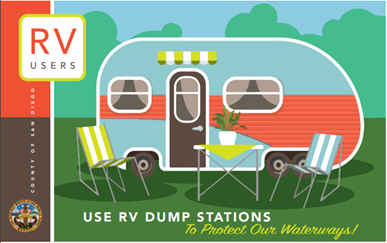WATER QUALITY IMPROVEMENTS

RV and Household Wastewater Safety & Pollution Prevention
When we think about summer safety, we typically think about things like applying sun block, wearing protective clothing, and preventing heat exhaustion. But did you know that another, lesser-known summertime safety concern is the disposal of RV wastewater? If not disposed of properly, RV wastewater can be a safety and environmental hazard and pose a threat to our waterways, aquatic life, and our own human health. RV blackwater (toilet waste) and graywater (shower and sink waste) contain harmful pollutants such as bacteria, parasites, chemicals, detergents, and excess nutrients which can cause toxic algae growth. If improperly dumped, contaminants can be carried into our storm drains and eventually reach our waterways and ocean without treatment.
You can play a key role in preventing polluted wastewater from entering our creeks, rivers, and ocean by following these wastewater disposal tips below.
|
RV Wastewater Disposal Tips
- Dispose of RV wastewater at a designated RV dump station using the County’s interactive dump station map. Never empty RV wastewater on the ground!
- Secure both ends of the hose before opening the tank valve, keeping an eye on the hose to make sure it stays connected. Be sure to close valves when the tanks aren’t being emptied.
- Rinse any residue or spills toward the dump station inlet pipe (connected to the sewer/septic system).
- Have spill response materials, like absorbent, ready to apply and sweep up — you never know what could happen!
- Keep the County of San Diego’s RV User Guide handy to remind you of proper disposal tips.
Septic System Maintenance
Like RV wastewater, household blackwater and graywater from toilets, laundry, showers, and sinks can also pose an environmental threat and safety hazard if your septic system is not properly maintained. A few key practices to keep in mind on a daily basis for proper maintenance and pollution prevention are to only flush the three P's (pee, poop, toilet paper), throw other materials (including flushable wipes) in the trash, and don't pour cooking grease or oils down the drain. The County of San Diego provides a number of resources on their webpage on how to maintain your septic system to prevent failures, as well as information on gray wash water and graywater systems that can be used to irrigate your yard or lawn. Visit the County’s Septic Rebate Program webpage which offers $100 rebates to residents in unincorporated areas of the County to pump their septic tanks.
The County reminds its residents that all sources of pollution are prohibited from leaving your property; only rainwater is allowed in the streets and storm drains. For other resources and tips to protect our local waterways, visit our Educational Handouts page.

|